A Kinetic Stem Cell Counting Analysis of the Specific Effects of Cell Culture Medium Growth Factors on Adipose-Derived Mesenchymal Stem Cells
Abstract
:1. Introduction
2. Materials and Methods
2.1. Cells
2.2. Cell Culture Medium and Growth Factor Supplements
- MesenPro RS™ Growth Supplement purchased from Thermo Fisher Scientific and supplemented as instructed by the supplier (“TFS”).
- 10% v/v fetal bovine serum purchased from Gibco-Thermo Fisher Scientific (#12662-011; “FBS”).
- 10% v/v pooled human sera purchased from Sigma-Aldrich (St. Louis, MO, USA; #H3667; “HS1”).
- 10% v/v pooled human sera purchased from Innovation Research (Upper Marlboro, MD, USA; #IPLA-SER; “HS2”).
- 5% v/v PLTGOLD® clinical grade human platelet lysate (hPL) purchased from Biological Industries USA (Captivate Bio, Watertown, MA, USA; #PLTGOLDXXXGMP; “hPL1”).
- 10% v/v clinical grade hPL purchased from Cook Regentec (Indianapolis, IN, USA; #G35220/G35221; “hPL2”).
2.3. Serial Culture
2.4. KSC Counting Software Analyses
- Stem cell-specific fraction (SCF).
- Stem cell symmetric self-renewal rate (RS, the rate at which stem cells divide to produce two stem cells).
- Stem cell-specific death rate (RDS).
- Committed progenitor cell (CPC)-specific death rate (RDT).
- Cell cycle time for asymmetrically self-renewing stem cells (GTA, the cell cycle time of stem cells when they divide asymmetrically, producing a stem cell and a first-generation CPC).
- Cell cycle time for symmetrically self-renewing stem cells (GTS, the cell cycle time of stem cells when they divide symmetrically, producing two stem cells).
- Cell cycle time for transiently amplifying CPCs (GTT).
- Turnover division number (TDN, the number of divisions by CPCs before they divide to produce a lineage generation of terminally-arrested cells).
3. Results
3.1. Comparative Analysis of Differences in the Cell Proliferation Kinetics of AdMSC-Containing Cells Serially Cultured with Different Growth Factor Supplements
3.2. KSC Counting Analysis of the Effects of Different Growth Factor Supplements on the Initial Cell Kinetics Factors in the Tissue Stem Cell Kinetics Turnover Unit Model

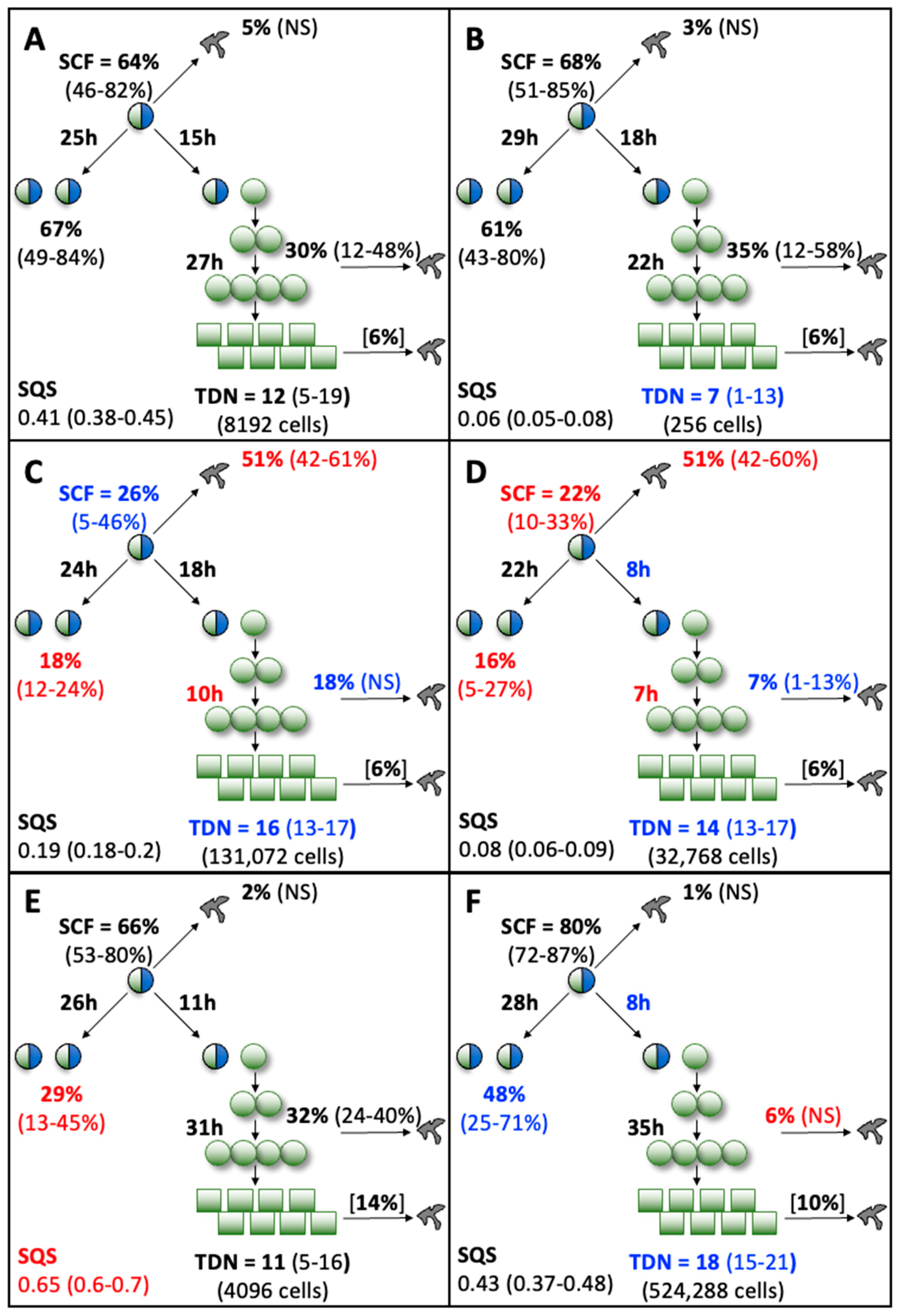
3.3. KSC Counting Analysis of Cell Subtype-Specific Kinetics Profiles Associated with Different Growth Factor Supplements during Serial Culture
3.4. Comparion of the KSC Counting-Derived Rapid Stem Cell Counting Algorithms Associated with Different Cell Culture Growth Factor Supplements
4. Discussion
Funding
Data Availability Statement
Acknowledgments
Conflicts of Interest
References
- Moll, G.; Ankrum, J.A.; Olson, S.D.; Nolta, J.A. Improved MSC minimal criteria to maximize patient safety: A call to embrace tissue factor and hemocompatibility assessment of MSC products. Stem Cells Transl. Med. 2022, 11, 2–13. [Google Scholar] [CrossRef]
- Mantri, S.; Reinisch, A.; Dejene, B.T.; Lyell, D.J.; DiGiusto, D.L.; Agarwal-Hashmi, R.; Majeti, R.; Weinberg, K.I.; Porteus, M.H. CD34 expression does not correlate with immunophenotypic stem cell or progenitor content in human cord blood products. Blood Adv. 2020, 4, 5357–5361. [Google Scholar] [CrossRef] [PubMed]
- Ambrosi, T.H.; Longaker, M.T.; Chan, C.K.F. A revised perspective of skeletal stem cell biology. Front. Cell Dev. Biol. 2019, 7, 189. [Google Scholar] [CrossRef] [Green Version]
- Sherley, J.L. Addressing challenges to progress in human stem cell toxicology concepts and practice. In Issues in Toxicology-Human Stem Cell Toxicology; Sherley, J.L., Ed.; No. 29; Royal Society of Chemistry: London, UK, 2016; pp. 1–8. [Google Scholar]
- Sherley, J.L. Dose determination for stem cell medicine: A need whose time has come. In Perinatal Stem Cells: Research and Therapy; Atala, A., Cetrulo, C., Cetrulo, K., Murphy, S.V., Taghizadeh, R., Eds.; Elsevier, Inc.: London, UK, 2018; pp. 383–397. [Google Scholar]
- Boutin, S.R.; Sherley, J.L. Advancing stem cell dosing for veterinary stem cell medicine. In Stem Cells in Veterinary Science; Choudhary, R.K., Choudhary, S., Eds.; Springer Nature Singapore Pte Ltd.: Singapore, 2021; pp. 2017–2021. [Google Scholar]
- Purton, L.E.; Scadden, D.T. Limiting factors in murine hematopoietic stem cell assays. Cell Stem Cell 2007, 1, 263–270. [Google Scholar] [CrossRef] [Green Version]
- McDermott, S.P.; Eppert, K.; Lechman, E.R.; Doedens, M.; Dick, J.E. Comparison of human cord blood engraftment between immunocompromised mouse strains. Blood 2010, 116, 193–200. [Google Scholar] [CrossRef] [PubMed] [Green Version]
- Dutton, R.; Abdi, F.; Minnetyan, L.; Sherley, J.L. A computational technology for specific counting of perinatal and postnatal human tissue stem cells for transplantation medicine. OBM Transplant. 2020, 4, 24. [Google Scholar] [CrossRef]
- Sherley, J.L.; Daley, M.P.; Dutton, R.A. Validation of Kinetic Stem Cell (KSC) counting algorithms for rapid quantification of human hematopoietic stem cells. J. Stem Cell Ther. Transplant. 2022, 6, 029–037. [Google Scholar] [CrossRef]
- Hoch, A.I.; Leach, J.K. Concise review: Optimizing expansion of bone marrow mesenchymal stem/stromal cells for clinical applications. Stem Cells Transl. Med. 2014, 3, 643–652, Erratum in: Stem Cells Transl. Med. 2015, 4, 412. [Google Scholar] [CrossRef]
- Meftahpour, V.; Malekghasemi, S.; Baghbanzadeh, A.; Aghebati-Maleki, A.; Pourakbari, R.; Fotouhi, A.; Aghebati-Maleki, L. Platelet lysate: A promising candidate in regenerative medicine. Regen. Med. 2021, 16, 71–85. [Google Scholar] [CrossRef]
- Shanbhag, S.; Stavropoulos, A.; Suliman, S.; Hervig, T.; Mustafa, K. Efficacy of humanized mesenchymal stem cell cultures for bone tissue engineering: A systematic review with a focus on platelet derivatives. Tissue Eng. Part B Rev. 2017, 23, 552–569. [Google Scholar] [CrossRef]
- Astori, G.; Amati, E.; Bambi, F.; Bernardi, M.; Chieregato, K.; Schäfer, R.; Sella, S.; Rodeghiero, F. Platelet lysate as a substitute for animal serum for the ex-vivo expansion of mesenchymal stem/stromal cells: Present and future. Stem. Cell Res. Ther. 2016, 7, 93. [Google Scholar] [CrossRef] [PubMed] [Green Version]
- Rambhatla, L.; Bohn, S.A.; Stadler, P.B.; Boyd, J.T.; Coss, R.A.; Sherley, J.L. Cellular senescence: Ex vivo p53-dependent asymmetric cell kinetics. J. Biomed. Biotechnol. 2001, 1, 27–36. [Google Scholar] [CrossRef] [PubMed] [Green Version]
- Merok, J.R.; Sherley, J.L. Breaching the kinetic barrier to in vitro somatic stem cell propagation. J. Biomed. Biotechnol. 2001, 1, 24–26. [Google Scholar] [CrossRef] [PubMed]
- Lee, H.-S.; Crane, G.G.; Merok, J.R.; Tunstead, J.R.; Hatch, N.L.; Panchalingam, K.; Powers, M.J.; Griffith, L.G.; Sherley, J.L. Clonal expansion of adult rat hepatic stem cell lines by suppression of asymmetric cell kinetics (SACK). Biotechnol. Bioeng. 2003, 83, 760–771. [Google Scholar] [CrossRef]
- Paré, J.-F.; Sherley, J.L. Biological principles for ex vivo adult stem cell expansion. In Current Topics in Developmental Biology; Schatten, G., Ed.; Elsevier, Inc.: San Diego, CA, USA, 2006; Volume 73, pp. 141–171. [Google Scholar]
- Taghizadeh, R.R.; Sherley, J.L. Expanding the Therapeutic Potential of Umbilical Cord Blood Hematopoietic Stem Cells. In Perinatal Stem Cells; Cetrulo, C.L., Cetrulo, K.J., Cetrulo, C.L., Jr., Eds.; Wiley-Blackwell: Hoboken, NJ, USA, 2009; pp. 21–40. [Google Scholar]
- Sherley, J.L. Accelerating progress in regenerative medicine by advancing distributed stem cell-based normal human cell biomanufacturing. Pharm. Anal. Acta 2014, 5, 286. [Google Scholar] [CrossRef] [Green Version]
- Potten, C.S.; Morris, R.J. Epithelial stem cells in vivo. J. Cell Sci. 1988, 10, 45–62. [Google Scholar] [CrossRef] [Green Version]
- Loeffler, M.; Potten, C.S. Stem cells and cellular pedigrees—A conceptual introduction. In Stem Cells; Potten, C.S., Ed.; Harcourt Brace & Co.: San Diego, CA, USA, 1997; pp. 1–28. [Google Scholar]
- Hayflick, L. The limited in vitro lifetime of human diploid cell stains. Exp. Cell Res. 1965, 37, 614–636. [Google Scholar] [CrossRef]
- Wagner, W.; Horn, P.; Castoldi, M.; Diehlmann, A.; Bork, S.; Saffrich, R.; Benes, V.; Blake, J.; Pfister, S.; Eckstein, V.; et al. Replicative senescence of mesenchymal stem cells: A continuous and organized process. PLoS ONE 2008, 3, e2213. [Google Scholar] [CrossRef] [Green Version]
- Bieback, K.; Hecker, A.; Schlechter, T.; Hofmann, I.; Brousos, N.; Redmer, T.; Besser, D.; Klüter, H.; Müller, A.M.; Becker, M. Replicative aging and differentiation potential of human adipose tissue-derived mesenchymal stromal cells expanded in pooled human or fetal bovine serum. Cytotherapy 2012, 14, 570–583. [Google Scholar] [CrossRef]
- Heathman, T.R.J.; Stolzing, A.; Fabian, C.; Rafiq, Q.A.; Coopman, K.; Nienow, A.W.; Kara, B.; Hewitt, C.J. Scalability and process transfer of mesenchymal stromal cell production from monolayer to microcarrier culture using human platelet lysate. Cytotherapy 2016, 18, 523–535. [Google Scholar] [CrossRef] [Green Version]
- Truong, N.C.; Bui, K.H.; Van Pham, P. Characterization of senescence of human adipose-derived stem cells after long-term expansion. Adv. Exp. Med. Biol. 2019, 1084, 109–128. [Google Scholar] [CrossRef] [PubMed]
- Mohammadi, S.; Nikbakht, M.; Mohammadi, A.M.; Panah, M.Z.; Ostadali, M.R.; Nasiri, H.; Ghavamzadeh, A. Human platelet lysate as a xeno free alternative of fetal bovine serum for the in vitro expansion of human mesenchymal stromal cells. Int. J. Hematol. Oncol. Stem Cell Res. 2016, 10, 161–171. [Google Scholar] [PubMed]
- Mangum, L.H.; Natesan, S.; Stone, R.; Wrice, N.L.; Larson, D.A.; Florell, K.F.; Christy, B.A.; Herzig, M.C.; Cap, A.P.; Christy, R.J. Tissue source and cell expansion condition influence phenotypic changes of adipose-derived stem cells. Stem Cells Int. 2017, 2017, 7108458. [Google Scholar] [CrossRef] [PubMed] [Green Version]
- Abdelrazik, H.; Spaggiari, G.M.; Chiossone, L.; Moretta, L. Mesenchymal stem cells expanded in human platelet lysate display a decreased inhibitory capacity on T- and NK-cell proliferation and function. Eur. J. Immunol. 2011, 41, 3281–3290. [Google Scholar] [CrossRef] [PubMed]
- Guiotto, M.; Raffoul, W.; Hart, A.M.; Riehle, M.O.; di Summa, P.G. Human platelet lysate to substitute fetal bovine serum in hMSC expansion for translational applications: A systematic review. J. Transl. Med. 2020, 18, 351. [Google Scholar] [CrossRef]
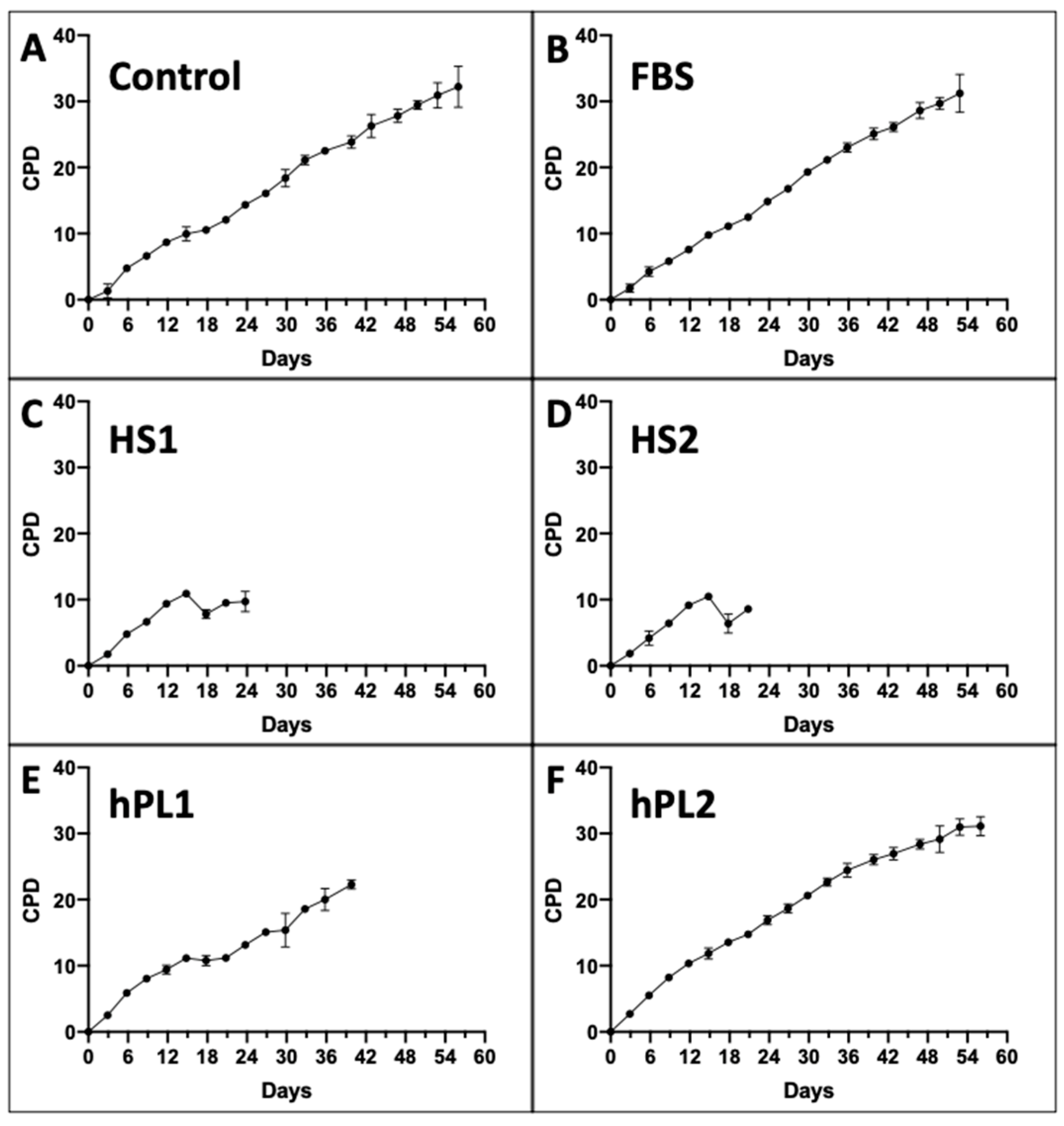
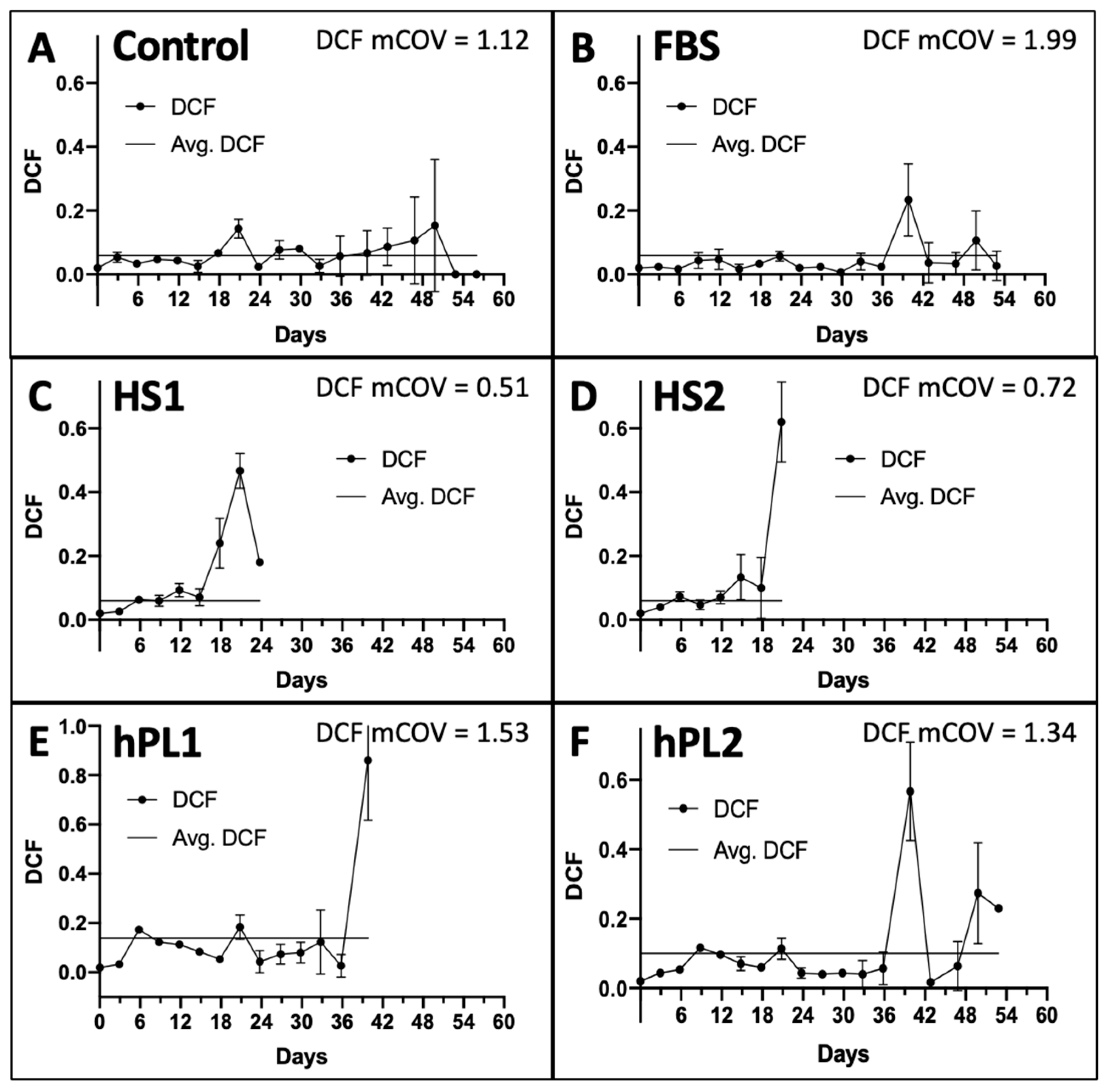
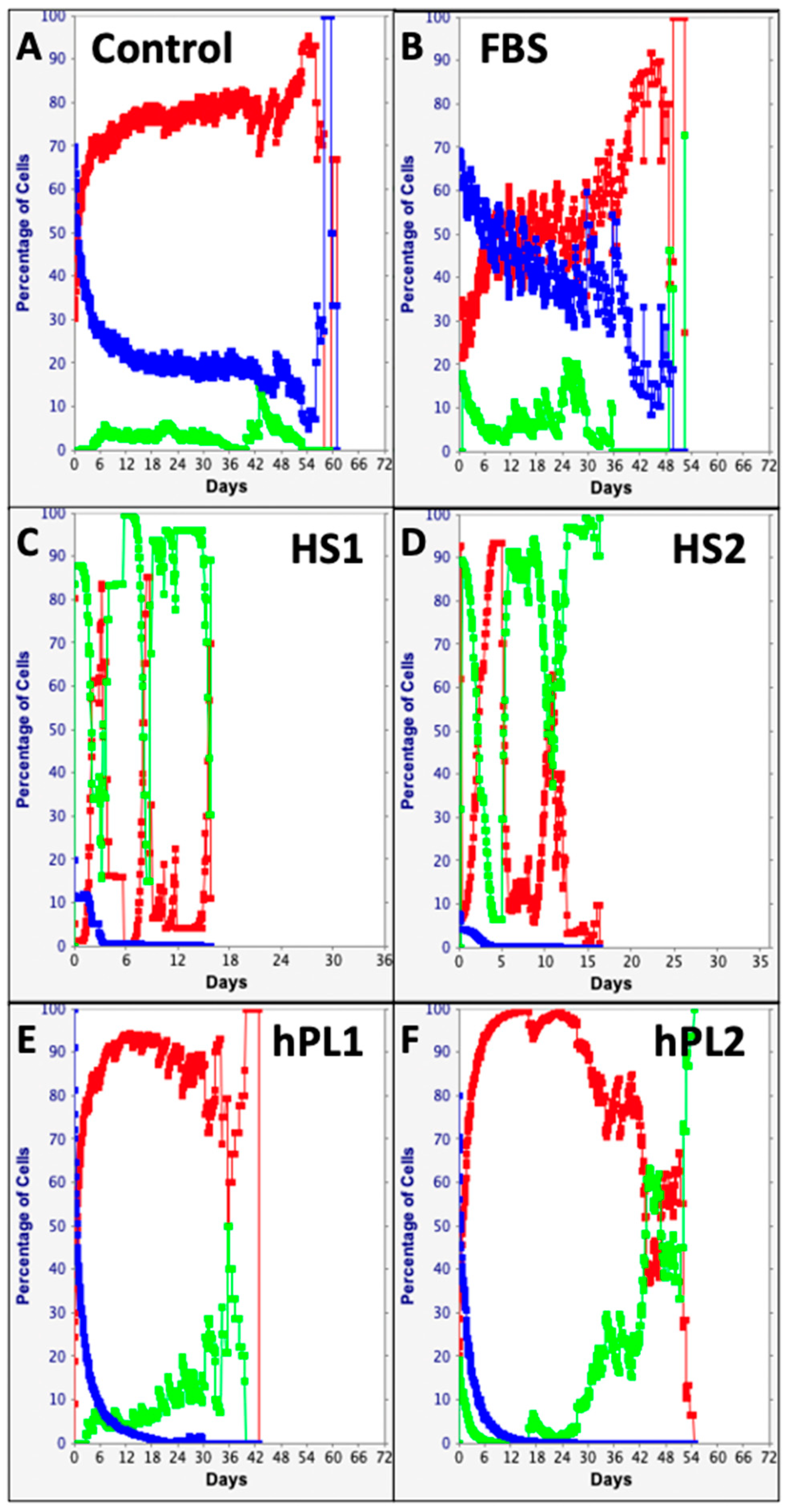
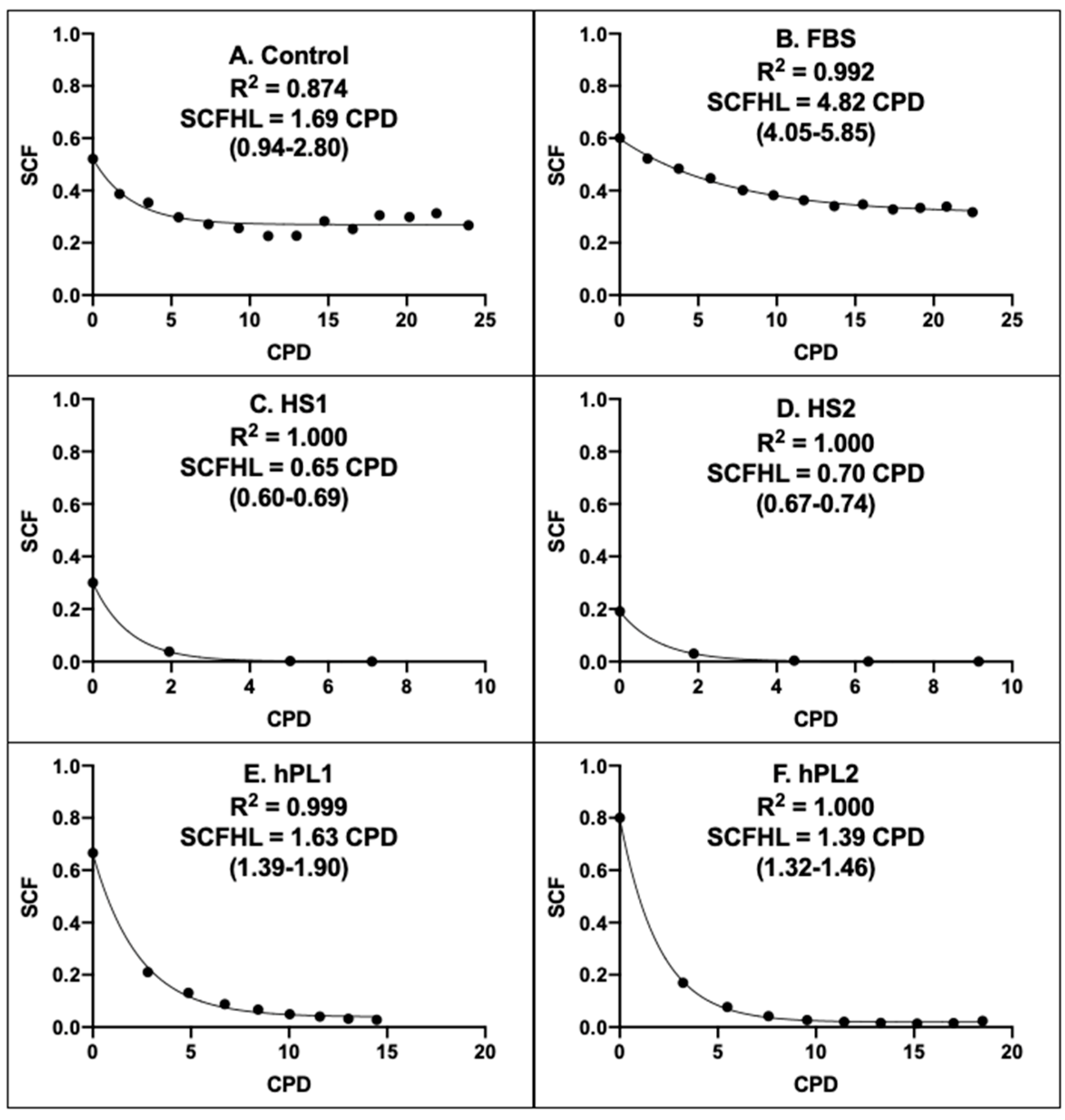
Disclaimer/Publisher’s Note: The statements, opinions and data contained in all publications are solely those of the individual author(s) and contributor(s) and not of MDPI and/or the editor(s). MDPI and/or the editor(s) disclaim responsibility for any injury to people or property resulting from any ideas, methods, instructions or products referred to in the content. |
© 2023 by the author. Licensee MDPI, Basel, Switzerland. This article is an open access article distributed under the terms and conditions of the Creative Commons Attribution (CC BY) license (https://creativecommons.org/licenses/by/4.0/).
Share and Cite
Sherley, J.L. A Kinetic Stem Cell Counting Analysis of the Specific Effects of Cell Culture Medium Growth Factors on Adipose-Derived Mesenchymal Stem Cells. Life 2023, 13, 614. https://doi.org/10.3390/life13030614
Sherley JL. A Kinetic Stem Cell Counting Analysis of the Specific Effects of Cell Culture Medium Growth Factors on Adipose-Derived Mesenchymal Stem Cells. Life. 2023; 13(3):614. https://doi.org/10.3390/life13030614
Chicago/Turabian StyleSherley, James L. 2023. "A Kinetic Stem Cell Counting Analysis of the Specific Effects of Cell Culture Medium Growth Factors on Adipose-Derived Mesenchymal Stem Cells" Life 13, no. 3: 614. https://doi.org/10.3390/life13030614
APA StyleSherley, J. L. (2023). A Kinetic Stem Cell Counting Analysis of the Specific Effects of Cell Culture Medium Growth Factors on Adipose-Derived Mesenchymal Stem Cells. Life, 13(3), 614. https://doi.org/10.3390/life13030614





